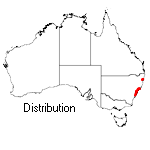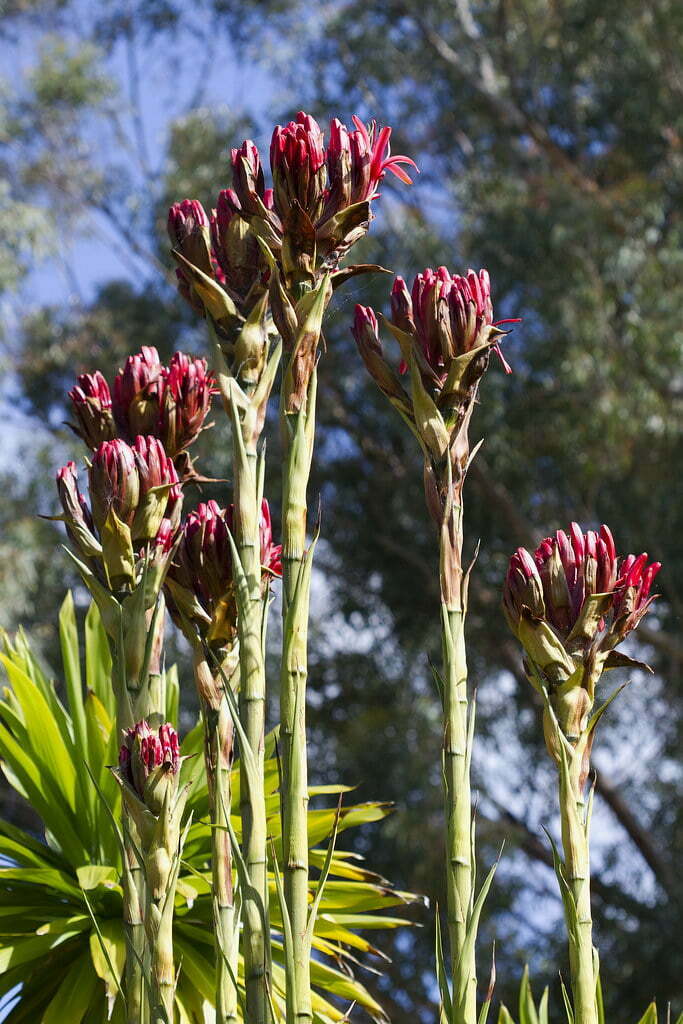
Doryanthes excelsa
Common name: Gymea Lily
· Part shade/full sun
· Height 2-4 metres
· Flowers Oct – Nov
· May not flower for up to 8 yrs
· Flower attracts birds
· Edible stems
· Cultural uses
Looks like: Each plant grows from a thickened underground stem which is gradually pulled deeper and deeper into the ground by the roots contracting during periods of dry weather. For this reason the plants do best in deep soil. The plant forms a large clump with numerous sword-like fibrous leaves, to 1 m in length and up to 100 mm wide. The red*, trumpet-like flowers each 100 mm across are borne in a compact terminal head 300 mm in diameter on a leafy flowering stem 2–4 m high. For this reason, and because they are surrounded by brown bracts, the flowers are not seen clearly from the ground. Flowering occurs from October to November in Canberra. The fruit is a woody capsule which splits open on ripening in January or February to release the brown, flattened and slightly winged seeds.
Habitat & Growing: Occurring naturally along the central coast of New South Wales. It has several popular names which reflect its size, appearance and distribution. Suitable for large rockeries and gardens, D. excelsa makes an interesting foliage plant, but must be sited with care to ensure a well-drained, deep soil, in full sun or partial shade. An ideal position would be below an elevated patio where its tall flower spike can be appreciated. The plant needs to be kept well watered. In spring a small quantity of blood and bone or a slow release fertiliser should be applied. Propagation is by division of established plants or from seed. Seed will germinate readily within 2 months if only a year or two old and is best sown in autumn. However, plants grown from seed will not flower until about 8 years of age. Although the foliage is resistant to frost damage, the developing flowerbuds need protection in areas of heavy frost, particularly if seed collection is planned. At the Australian National Botanic Gardens this protection used to be provided by a hessian-covered frame at the top of a tall pipe and mounted over the flowerbuds. In recent years, with reduced frost, the flower spikes are left uncovered and provide a handsome display in most years.
D. excelsa is seldom attacked by pests or diseases, although the flower-head may occasionally be damaged by birds feeding on its nectar.
| Family | Doryanthaceae |
| Plant Type | Clumping perennial |
| Width | 3 |
| Flowering Time | Spring, Summer, Autumn |
| Soil Type | Clay, Loamy, Sandy loam, Clay loam, Poor soil |
| Climate Zone | Sub-tropical, Warm temperate, Cool temperate, Mediterranean |
| Growth Habit | Evergreen |
| Soil Moisture | Well-drained, Moist moderate drainage |
| Special Uses | Cut flower, Erosion control, Pollution tolerant, Playground friendly |
| Height | 4 |
| Flower Colour | Red |
| pH Level | Acid, Neutral |
| Plant Environment | Low maintenance garden, Container growing, Coastal garden, Drought resistant |
| Light | Sunny, Light shade, Half shade |
| Lifespan | Perennial |
| Frost Tolerance | Tolerates light frost |
| Attracts Wildlife | Bees, Nectar eating birds, Butterflies, Other insects |
Distribution: Occurring naturally along the central coast and Sydney of New South Wales.

Traditional uses: Aboriginal people roasted the young stems of Gymea lily for eating. They also roasted the roots to make a kind of cake. Fibres from the leaves were used for making brushes and matting

